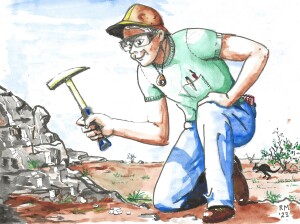To stumble upon in the field and recognise it for what it is – outcropping mineralisation with the grade and size potential to become an orebody. A long-anticipated moment of fierce joy and satisfaction for the lone prospector or exploration geologist. I does not happen very often but is the moment we all live for.
A moment of fierce joy
In a near 60-year career this experience has only happened to me three times. Two of these discovery outcrops eventually led to operating mines, the third, after years of exploration and drill testing, failed to make the cut (I still think it will be a mine someday, so I will say no more on that one)). I take only modest credit for these discoveries. I was first on the ground and got the naming rights for the prospect and subsequent mines, but was part of a team, and a large element of luck was involved. All this happened 30-50 years ago when not all the low-hanging fruit had been plucked. Prospecting discovery of significant outcropping mineralisation happens increasingly less these days. Maybe in a remote and under-prospected third world country? If there are any such left in this globalised world.
The Greenfields (1) gold deposit near Coolgardie in Western Australia, which I identified in the course of 1:5000 scale geological mapping, was named for the field below which it lay – full of Spring grass and wildflowers and big eucalypt trees when I first came upon it in 1984. I hoped that the name would preserve the memory of this pleasant little valley long after the bulldozers had moved in. Greenfields open cut mine is long exhausted, but the Greenfields Mill still operates today as a Toll facility for other gold mines in the district.
The Magellan Pb deposit near Wiluna in Western Australia was an entirely serendipitous discovery of high-grade (2) outcropping mineralisation which I made in in 1991 in the course of checking old gold claims in nearby rocks. That day was the first time that I had used a GPS unit in the field. This was a hand-held instrument made by a company called Magellan and the size and weight of a house brick, but a revelation and a boon. I thought it a cool name so gave it to my discovery. Magellan was the first discovery in a new and unique lead province. Later prospects in the area followed the same theme and named for 15th Century Spanish and Portuguese explorers. The Magellan lead mine is still in operation today although environmental restrictions have severely restricted its operations.
Discovery of outcropping mineralisation is invariably followed by collecting rock samples for assay. The different types of rock chip sampling and how to collect them are detailed in an earlier blog post here.
(1) The name I gave was actually Greenfield, but the company later added the final “s”, probably because they wanted investors to think they had more than one.
(2) The first suite of rock chip samples from Magellan, collected from over 5km of strike, came back 5%-35% Pb. Near pure cerussite.
